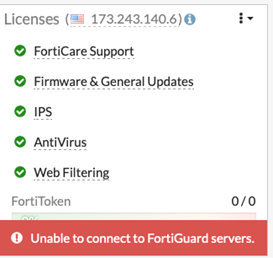- Support Forum
- Knowledge Base
- Customer Service
- Internal Article Nominations
- FortiGate
- FortiClient
- FortiADC
- FortiAIOps
- FortiAnalyzer
- FortiAP
- FortiAuthenticator
- FortiBridge
- FortiCache
- FortiCare Services
- FortiCarrier
- FortiCASB
- FortiConverter
- FortiCNP
- FortiDAST
- FortiData
- FortiDDoS
- FortiDB
- FortiDNS
- FortiDLP
- FortiDeceptor
- FortiDevice
- FortiDevSec
- FortiDirector
- FortiEdgeCloud
- FortiEDR
- FortiEndpoint
- FortiExtender
- FortiGate Cloud
- FortiGuard
- FortiGuest
- FortiHypervisor
- FortiInsight
- FortiIsolator
- FortiMail
- FortiManager
- FortiMonitor
- FortiNAC
- FortiNAC-F
- FortiNDR (on-premise)
- FortiNDRCloud
- FortiPAM
- FortiPhish
- FortiPortal
- FortiPresence
- FortiProxy
- FortiRecon
- FortiRecorder
- FortiSRA
- FortiSandbox
- FortiSASE
- FortiSASE Sovereign
- FortiScan
- FortiSIEM
- FortiSOAR
- FortiSwitch
- FortiTester
- FortiToken
- FortiVoice
- FortiWAN
- FortiWeb
- FortiAppSec Cloud
- Lacework
- Wireless Controller
- RMA Information and Announcements
- FortiCloud Products
- ZTNA
- 4D Documents
- Customer Service
- Community Groups
- Blogs
- Fortinet Community
- Knowledge Base
- FortiGate
- Technical Tip: FortiGuard is not reachable via Any...
- Subscribe to RSS Feed
- Mark as New
- Mark as Read
- Bookmark
- Subscribe
- Printer Friendly Page
- Report Inappropriate Content
Created on
11-13-2020
04:25 AM
Edited on
12-09-2025
03:35 AM
By
Anthony_E
Description
This article describes how to troubleshoot FortiGuard connectivity when the Anycast default method does not work.
Scope
FortiGate v6.4.3 and above.
Solution
By default, v6.4.3 and above uses the Anycast method to address the FortiGuard servers. Relying on Fortinet DNS servers, the FortiGate will get a single IP address for the domain name of each FortiGuard service.
In some circumstances, Anycast does not work:

- Switch to other Anycast servers:
set fortiguard-anycast-source aws
end
-
Disable Anycast and use HTTPS with port 8888.
config system fortiguard
set fortiguard-anycast disable
set protocol https
set port 8888
set sdns-server-ip 208.91.112.220 173.243.140.53 210.7.96.53
end

-
Disable Anycast and use UDP with Port 53.
set fortiguard-anycast disable
set protocol udp
set port 53
set sdns-server-ip 208.91.112.220 173.243.140.53 210.7.96.53
end
-
Disable Anycast and use UDP with Port 8888.
config system fortiguard
set fortiguard-anycast disable
set protocol udp
set port 8888
This can be verified with the debug command 'diagnose debug rating', presenting multiple servers available:
- This article mainly pertains to the newer Anycast method for FortiGuard communications. For legacy deployments, Anycast is not available. To troubleshoot without Anycast, refer to this article: Troubleshooting Tip: Resolving FDS Communication Issues (FortiGuard Distribution Servers).
- The status of FortiGuard Anycast servers can be confirmed on the FortiGuard status page.
Related articles:
Troubleshooting Tip: Unable to connect to FortiGuard servers
The Fortinet Security Fabric brings together the concepts of convergence and consolidation to provide comprehensive cybersecurity protection for all users, devices, and applications and across all network edges.
Copyright 2025 Fortinet, Inc. All Rights Reserved.
